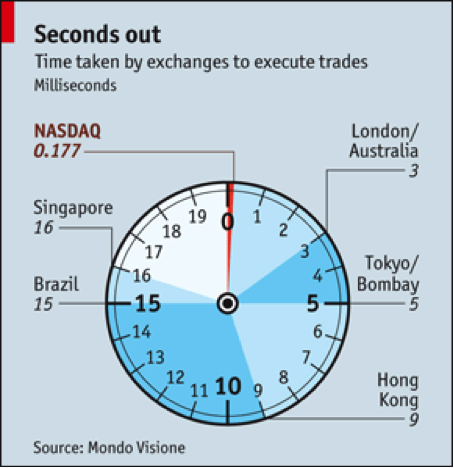IDC HPC Forum
9/6/16 – 9/8/16

Today’s financial service organizations rely on technology to support and accelerate high-frequency trading (HFT). In order to remain competitive in this ever-evolving marketplace, firms must be willing to invest in a technology stack that not only facilitates decision-making but also lessens “speed bumps” in the connections between traders and exchanges.
Exploiting the latest market innovations is one of the greatest daily challenges faced by financial organizations. Former HFT trader Jacob Loveless adds to the conversation, “As soon as you discover [a solution], you have only a few weeks to capitalize on it; then you have to start all over.” When organizations identify a new method to shave microseconds off of trading time, they must quickly spend exorbitant amounts of money to fully leverage the benefits, or risk losing out to their competitors.
An effective HFT strategy consists of continuously pursuing new avenues of efficiency to outpace rival investors. Because profits are now directly linked to the use of Big Data analytics, building an infrastructure that can rapidly store, retrieve, and process enormous volumes of information is critical. The need for speed is so intense, traders vie for low-latency real estate in data centers, and even the length of a cable from a trader’s desk to the exchange can have a monumental impact on the success of a trade. In fact, an estimated one-millisecond advantage can turn an annual profit of $100 million dollars.

In an effort to accelerate HFT, high performance computing (HPC) together with Big Data insights are being used to expedite transactions and promote data optimization. Successful financial organizations are investing in end-to-end computing solutions that can execute hundreds of trades per millisecond, including bundles of hardware and software that offer high-speed processing capabilities – an IT transformation that allows organizations to streamline operations, increase trader productivity, and boost network performance.
To further minimize delays, many financial organizations are investing in Trade and Match Server solutions, specifically designed to combat latency and data management issues associated with HFT. Firms utilizing Trade and Match Servers can maintain low latency and seamless connectivity under high volumes of traffic, allowing algorithmic traders to recognize and purchase lagging stock, hold it for a few milliseconds until the prices equalize, and then sell it for a profit.
Investing in high-intelligence trading technologies is non-negotiable for traders as machines have completely dominated today’s marketplace. Capable of enacting on vast quantities of data at a staggering rate, supercomputers allow traders to execute transactions swiftly and, more importantly, to make informed and immediate business decisions. It is no wonder then that survival in this fast-paced industry hinges on the latest and fastest HPC solutions.
The world of finance is inundated with challenges to execute trades with the utmost efficiency. As HFT moves from microseconds to nanoseconds, organizations must strive to become progressively better connected and capable of supporting massive amounts of data by investing in a powerful and scalable technology stack. Those that commit will gain the ability to compete and potentially lead the marketplace, promoting more effective trading and a continuously expanding bottom line.